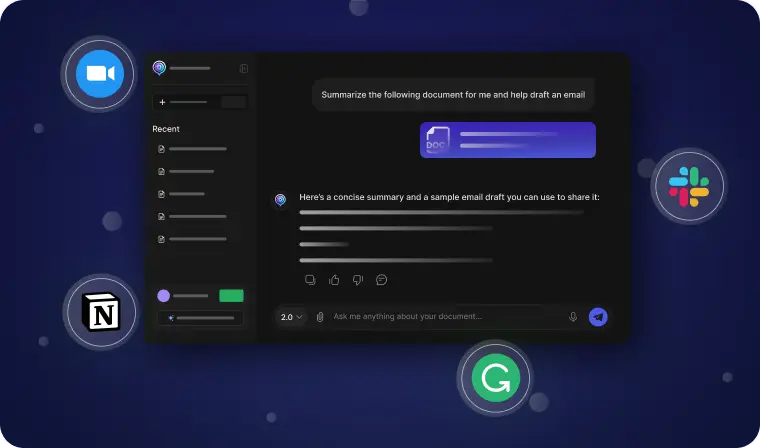





Embedded AI refers to AI-powered features built directly into widely used SaaS platforms. These include tools like Microsoft 365 Copilot, Grammarly, Slack AI, Zoom AI Companion, Notion AI, and many others. Unlike standalone AI tools, embedded AI features are accessed within familiar workflows and software.
They do not require separate authentication, appear as native functionalities, and are often enabled by default. There is no separate domain to monitor, no external traffic to flag, and no formal rollout to control.
Consider these common examples:
Conventional security frameworks are designed to detect familiar threat vectors: unauthorized applications, external data transfers, and anomalous user behavior. Embedded AI bypasses these controls entirely.
Fundamentally, today’s governance frameworks are not built to interrogate what AI models embedded in enterprise platforms are doing. Without insight into the data they access, the outputs they generate, or the decisions they influence, organizations lack the situational awareness required to govern these systems effectively.
The risk surface introduced by embedded AI is multifaceted and expanding across several critical dimensions:
This risk is not diminishing. It is accelerating.
Gartner projects that by 2026, 40% of enterprise applications will include task-specific AI agents, and 80% of independent software vendors will embed AI into their platforms.
At the same time, Gartner’s 2025 TRiSM guidance identifies embedded and agentic AI as priority governance targets, citing a growing gap between policy and practice across enterprises.
Most organizations have documented AI policies, but they lack the runtime enforcement and contextual controls needed to implement them effectively. With legal mandates expected by 2027, the requirement to govern embedded AI is no longer optional.
Singulr is the first Unified AI Control Plane architected to detect and govern all forms of AI across the enterprise landscape, including embedded AI, public generative AI services, and internally developed systems. Its layered architecture and contextual intelligence deliver the operational clarity, security, and governance leaders require to manage AI risk at scale.
Singulr continuously inventories AI activity across the enterprise stack. This includes not only sanctioned applications and proprietary models, but also embedded AI features that operate within trusted SaaS platforms.
The system identifies specific AI capabilities in use, such as summarization, chat, coaching, or drafts by Copilot, along with the user and the usage context for supported platforms like Microsoft 365.
This continuously updated knowledge graph catalogs millions of AI agents, services, datasets, and models, enriched with metadata on:
This intelligence enables real-time evaluation of model behavior, risk posture, and compliance alignment.
Singulr maps AI usage to individual user identities and privilege levels. It distinguishes between corporate and personal account activity, flags cross-domain usage, and highlights interactions involving regulated business units. This is essential for detecting unauthorized access and preventing exposure through shadow AI.
Singulr addresses the “black box” problem every large enterprise faces. Long-standing software and SaaS relationships are being transformed by solution providers incorporating AI agents, services, and features that you can’t see and that they may not be disclosing. Traditional security and governance architectures fall short when faced with this problem - you approved the use of these solutions without factoring in AI use cases. Singulr allows you to see who and how those solutions are leveraging AI.
Singulr enforces live, context-aware controls designed for high-risk environments, including:
Singulr provides centralized visibility through real-time dashboards, enabling stakeholders to monitor AI activity across departments, platforms, and risk categories.
Reporting is designed to support alignment with major regulatory and industry frameworks, including the EU AI Act, NIST AI Risk Management Framework, and ISO/IEC 42001. All relevant AI interactions are logged, categorized, and linked to the organization’s broader compliance and risk posture.
Embedded AI is not a future concern. It is already operating within your most trusted applications, often without oversight. Singulr helps security and governance teams surface these blind spots, assess real risk, and enforce policies at scale without slowing innovation.
To see how Singulr can bring visibility and control to embedded AI in your environment, request a personalized demo with our team.
Book a Demo Here.
1. What qualifies as embedded AI within an application?
Embedded AI refers to AI-powered capabilities that are integrated directly into widely used SaaS platforms. These features are native and don’t require separate user action, authentication, or deployment. Common examples include document summarization in Microsoft 365, conversation analysis in Slack, and predictive insights in Salesforce or Notion.
2. Why is embedded AI difficult to detect using traditional security tools?
Embedded AI runs within approved software, inheriting the platform’s permissions, and generates activity that resembles standard user behavior. They do not create new domains, require separate authentication, or trigger conventional anomaly detection, making them effectively invisible to legacy controls.
3. What are the compliance risks associated with embedded AI?
Embedded AI features process, store, or train on data that includes personally identifiable information (PII), protected health information (PHI), and other regulated content. Without oversight and controls, they can lead to violations under frameworks such as GDPR, HIPAA, and the EU AI Act.
4. Can enterprises disable embedded AI features?
In most enterprise-tier plans, vendors offer administrative controls to manage embedded AI functionalities. These include the ability to disable data sharing for model training and configure data retention policies to restrict data exfiltration. However, these controls are often unavailable or limited in personal, free-tier, or unmanaged accounts. Even where controls exist, they may require manual configuration and lack the granularity needed for continuous, context-aware enforcement across diverse user groups.

